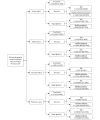Identifying the Severity of Heart Valve Stenosis and Regurgitation Among a Diverse Population Within an Integrated Health Care System: Natural Language Processing Approach
- PMID: 39348175
- PMCID: PMC11474122
- DOI: 10.2196/60503
Identifying the Severity of Heart Valve Stenosis and Regurgitation Among a Diverse Population Within an Integrated Health Care System: Natural Language Processing Approach
Abstract
Background: Valvular heart disease (VHD) is a leading cause of cardiovascular morbidity and mortality that poses a substantial health care and economic burden on health care systems. Administrative diagnostic codes for ascertaining VHD diagnosis are incomplete.
Objective: This study aimed to develop a natural language processing (NLP) algorithm to identify patients with aortic, mitral, tricuspid, and pulmonic valve stenosis and regurgitation from transthoracic echocardiography (TTE) reports within a large integrated health care system.
Methods: We used reports from echocardiograms performed in the Kaiser Permanente Southern California (KPSC) health care system between January 1, 2011, and December 31, 2022. Related terms/phrases of aortic, mitral, tricuspid, and pulmonic stenosis and regurgitation and their severities were compiled from the literature and enriched with input from clinicians. An NLP algorithm was iteratively developed and fine-trained via multiple rounds of chart review, followed by adjudication. The developed algorithm was applied to 200 annotated echocardiography reports to assess its performance and then the study echocardiography reports.
Results: A total of 1,225,270 TTE reports were extracted from KPSC electronic health records during the study period. In these reports, valve lesions identified included 111,300 (9.08%) aortic stenosis, 20,246 (1.65%) mitral stenosis, 397 (0.03%) tricuspid stenosis, 2585 (0.21%) pulmonic stenosis, 345,115 (28.17%) aortic regurgitation, 802,103 (65.46%) mitral regurgitation, 903,965 (73.78%) tricuspid regurgitation, and 286,903 (23.42%) pulmonic regurgitation. Among the valves, 50,507 (4.12%), 22,656 (1.85%), 1685 (0.14%), and 1767 (0.14%) were identified as prosthetic aortic valves, mitral valves, tricuspid valves, and pulmonic valves, respectively. Mild and moderate were the most common severity levels of heart valve stenosis, while trace and mild were the most common severity levels of regurgitation. Males had a higher frequency of aortic stenosis and all 4 valvular regurgitations, while females had more mitral, tricuspid, and pulmonic stenosis. Non-Hispanic Whites had the highest frequency of all 4 valvular stenosis and regurgitations. The distribution of valvular stenosis and regurgitation severity was similar across race/ethnicity groups. Frequencies of aortic stenosis, mitral stenosis, and regurgitation of all 4 heart valves increased with age. In TTE reports with stenosis detected, younger patients were more likely to have mild aortic stenosis, while older patients were more likely to have severe aortic stenosis. However, mitral stenosis was opposite (milder in older patients and more severe in younger patients). In TTE reports with regurgitation detected, younger patients had a higher frequency of severe/very severe aortic regurgitation. In comparison, older patients had higher frequencies of mild aortic regurgitation and severe mitral/tricuspid regurgitation. Validation of the NLP algorithm against the 200 annotated TTE reports showed excellent precision, recall, and F1-scores.
Conclusions: The proposed computerized algorithm could effectively identify heart valve stenosis and regurgitation, as well as the severity of valvular involvement, with significant implications for pharmacoepidemiological studies and outcomes research.
Keywords: algorithm; echocardiography report; heart valve; natural language processing; regurgitation; stenosis.
©Fagen Xie, Ming-sum Lee, Salam Allahwerdy, Darios Getahun, Benjamin Wessler, Wansu Chen. Originally published in JMIR Cardio (https://cardio.jmir.org), 30.09.2024.
Conflict of interest statement
Conflicts of Interest: None declared.
Figures



Similar articles
-
Echocardiographic assessment of mitral stenosis and its associated valvular lesions in 205 patients and lack of association with mitral valve prolapse.J Am Soc Echocardiogr. 1997 Mar;10(2):141-8. doi: 10.1016/s0894-7317(97)70086-5. J Am Soc Echocardiogr. 1997. PMID: 9083969
-
[Clinical characteristics of patients with moderate or severe valvular heart disease].Zhonghua Xin Xue Guan Bing Za Zhi. 2024 Oct 24;52(10):1200-1206. doi: 10.3760/cma.j.cn112148-20230816-00082. Zhonghua Xin Xue Guan Bing Za Zhi. 2024. PMID: 39428370 Chinese.
-
'Color Doppler stripes' make it difficult to diagnose the severity of valvular heart diseases: a report of two cases.Cardiovasc Ultrasound. 2024 Oct 7;22(1):12. doi: 10.1186/s12947-024-00331-1. Cardiovasc Ultrasound. 2024. PMID: 39370511 Free PMC article.
-
[The best of valvular heart disease in 2006].Arch Mal Coeur Vaiss. 2007 Jan;100 Spec No 1:19-28. Arch Mal Coeur Vaiss. 2007. PMID: 17405561 Review. French.
-
Comprehensive Nursing Management for Valvular Disease.Crit Care Nurs Clin North Am. 2019 Mar;31(1):31-38. doi: 10.1016/j.cnc.2018.11.002. Epub 2018 Dec 22. Crit Care Nurs Clin North Am. 2019. PMID: 30736933 Review.
References
-
- Coffey S, Cox B, Williams MJ. The prevalence, incidence, progression, and risks of aortic valve sclerosis: a systematic review and meta-analysis. J Am Coll Cardiol. 2014 Jul 01;63(25 Pt A):2852–2861. doi: 10.1016/j.jacc.2014.04.018. https://linkinghub.elsevier.com/retrieve/pii/S0735-1097(14)02217-7 S0735-1097(14)02217-7 - DOI - PubMed
-
- Osnabrugge RL, Mylotte D, Head SJ, Van Mieghem NM, Nkomo VT, LeReun CM, Bogers AJ, Piazza N, Kappetein AP. Aortic stenosis in the elderly: disease prevalence and number of candidates for transcatheter aortic valve replacement: a meta-analysis and modeling study. J Am Coll Cardiol. 2013 Sep 10;62(11):1002–1012. doi: 10.1016/j.jacc.2013.05.015. https://linkinghub.elsevier.com/retrieve/pii/S0735-1097(13)02079-2 S0735-1097(13)02079-2 - DOI - PubMed
MeSH terms
LinkOut - more resources
Full Text Sources

